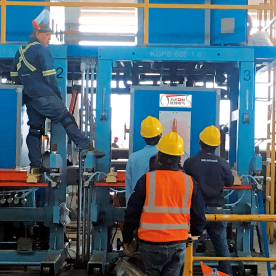[Solid state HF welder with temperature control]Exploring the Advantages of Solid State HF Welder with Temperature Control for Enhanced Welding Precision and Efficiency
News 2024-8-3
In the ever-evolving landscape of manufacturing and engineering, welding technologies play a pivotal role in ensuring the integrity and performance of various industrial components. Among the variety of welding techniques available, solid state high-frequency (HF) welding has emerged as a popular choice due to its capability to deliver high-strength welds with minimal thermal distortion. A significant advancement in this arena is the integration of temperature control systems within solid state HF welders, which greatly enhances their performance, efficiency, and safety.
Understanding Solid State HF Welding

Exploring the Advantages of Solid State HF Welder with Temperature Control for Enhanced Welding Precision and Efficiency
The Role of Temperature Control
Temperature control is a significant innovation that complements the solid state HF welding technology. In conventional welding processes, excessive heat can lead to a range of issues, such as warping, degradation of material properties, and an overall decline in weld integrity. However, solid state HF welders with integrated temperature control systems significantly mitigate these risks.
A temperature control system ensures that the welding process operates within optimal thermal limits, granting manufacturers enhanced control over the heating and cooling cycles during welding. This is crucial for producing consistent and repeatable weld quality, enabling engineers to set precise parameters based on the material type and thickness. By maintaining an ideal temperature range, the solid state HF welder facilitates better fusion of the materials, resulting in stronger and more durable welds.
Benefits of Solid State HF Welders with Temperature Control

Exploring the Advantages of Solid State HF Welder with Temperature Control for Enhanced Welding Precision and Efficiency
2. **Increased Efficiency**: With a precise temperature control feature, welders can optimize the welding time based on the material properties and thickness, leading to reduced cycle times. This increased efficiency not only enhances productivity but also contributes to significant cost savings in manufacturing processes.

Exploring the Advantages of Solid State HF Welder with Temperature Control for Enhanced Welding Precision and Efficiency
4. **Reduced Energy Consumption**: By optimizing the welding temperature, manufacturers can minimize energy consumption. The solid state technology already offers improved efficiency compared to older welding techniques, and the addition of temperature control further reduces overall energy costs.
5. **Enhanced Safety**: Temperature control also plays a significant role in ensuring operator safety. By preventing overheating and potential hazards, manufacturers can create a safer working environment, reducing the risk of workplace accidents and injuries.
Conclusion
The integration of temperature control in solid state HF welders marks a monumental step forward in welding technology. By delivering precise temperature regulation, these advanced systems enhance weld quality, increase efficiency, and promote safety in industrial operations. As industries continue to seek more sustainable and cost-effective manufacturing solutions, solid state HF welders with temperature control are fast becoming the gold standard in high-performance welding applications. The result is a transformative impact on production capabilities, enabling businesses to meet the high demands of modern manufacturing while ensuring the durability and reliability of their products.
